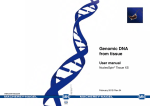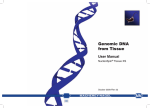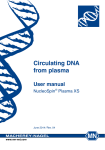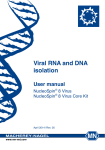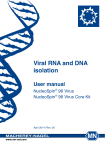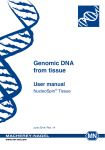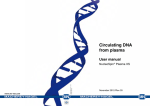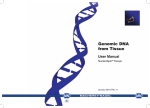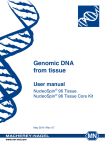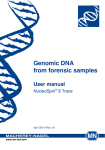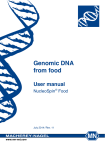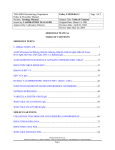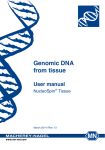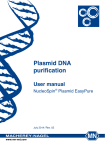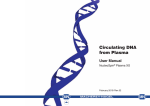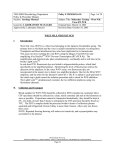Download Genomic DNA from tissue
Transcript
Genomic DNA from tissue User manual NucleoSpin® Tissue XS May 2014 / Rev. 06 Genomic DNA from tissue Protocol-at-a-glance (Rev. 06) NucleoSpin® Tissue XS 1 Prepare sample Up to 2.5 mg tissue 2 Pre-lyse sample 80 μL T1 8 μL Proteinase K 56 °C, 1–4 h 3 Lyse sample 80 μL B3 70 °C, 5 min 4 5 Adjust binding conditions 80 μL ethanol Bind DNA Load lysate 11,000 x g, 1 min 6 7 Wash silica membrane 50 μL B5 1st wash 11,000 x g, 1 min 2nd wash 11,000 x g, 2 min 50 μL B5 Elute DNA 20 μL BE 11,000 x g, 1 min 8 Optional: Remove residual ethanol Optional: 90 °C, 8 min MACHEREY-NAGEL GmbH & Co. KG · Neumann-Neander-Str. 6–8 · 52355 Düren · Germany Tel.: +49 24 21 969-270 · Fax: +49 24 21 969-199 · [email protected] · www.mn-net.com Genomic DNA from tissue Table of contents 1 Components 4 1.1 Kit contents 4 1.2 Reagents, consumables, and equipment to be supplied by user 5 1.3 About this user manual 5 2 Product description 6 2.1 The basic principle 6 2.2 Kit specifications 6 2.3 Handling of sample material 8 2.4 Elution procedures 9 2.5 Removal of residual traces of ethanol for highest sensitivity in downstream applications 10 3 Storage conditions and preparation of working solutions 12 4 Safety instructions 13 5 Protocols 15 5.1 Protocol for human or animal tissue 15 5.2 Protocol for cultured cells 18 5.3 Protocol for paraffin-embedded tissue 21 5.4 Protocol for dried blood spots (Guthrie cards) 24 5.5 Protocol for buccal swabs 26 5.6 Protocol for laser-microdissected tissue 28 5.7 Protocol for blood samples 29 6Appendix 30 6.1Troubleshooting 30 6.2 Ordering information 31 6.3 Product use restriction / warranty 31 MACHEREY-NAGEL – 05 / 2014, Rev. 06 3 Genomic DNA from tissue 1 Components 1.1 Kit contents NucleoSpin® Tissue XS 10 preps 50 preps 250 preps 740901.10 740901.50 740901.250 Lysis Buffer T1 5 mL 10 mL 50 mL Lysis Buffer B3 10 mL 10 mL 60 mL Wash Buffer B5 (Concentrate)* 6 mL 6 mL 6 mL Elution Buffer BE** 13 mL 13 mL 13 mL Proteinase K (lyophilized)* 6 mg 20 mg 2 x 50 mg 1.8 mL 1.8 mL 8 mL NucleoSpin® Tissue XS Columns (green rings) 10 50 250 Collection Tubes (2 mL) 20 100 500 User manual 1 1 1 REF Proteinase Buffer PB * For preparation of working solutions and storage conditions see section 3. **Composition of Elution Buffer BE: 5 mM Tris/HCl, pH 8.5 4 MACHEREY-NAGEL – 05 / 2014, Rev. 06 Genomic DNA from tissue 1.2 Reagents, consumables, and equipment to be supplied by user Reagents • 96–100% ethanol Consumables • • 1.5 mL microcentrifuge tubes for sample lysis and DNA elution Disposable tips Equipment • Manual pipettors • Vortex mixer • • • Centrifuge for microcentrifuge tubes Thermal heating-block Personal protection equipment (lab coat, gloves, goggles) 1.3 About this user manual It is strongly recommended reading the detailed protocol sections of this user manual if the NucleoSpin® Tissue XS kit is used for the first time. Experienced users, however, may refer to the Protocol-at-a-glance instead. The Protocol-at-a-glance is designed to be used only as a supplemental tool for quick referencing while performing the purification procedure. All technical literature is available on the internet at www.mn-net.com. Please contact Technical Service ([email protected]) regarding information about changes of the current user manual compared to previous revisions. MACHEREY-NAGEL – 05 / 2014, Rev. 06 5 Genomic DNA from tissue 2 Product description 2.1 The basic principle The NucleoSpin® Tissue XS kit is designed for the efficient isolation of genomic DNA from small samples of different kinds of cells and tissues, such as laser-microdissected samples, small amounts of blood, or dried blood spots and forensic samples. Due to a special funnel design the NucleoSpin® Tissue XS Columns allow very small elution volumes (5–30 μL) which results in highly concentrated DNA. Lysis is achieved by incubation of the sample material in a Proteinase K supplemented lysis buffer. Appropriate conditions for binding of the DNA to a silica membrane are created by adding ethanol. The mixture is applied to the NucleoSpin® Tissue XS Column and DNA binds to a silica membrane. Two subsequent washing steps efficiently remove contaminations and highly pure DNA is finally eluted with 5–30 μL of a slightly alkaline elution buffer of low ionic strength (5 mM Tris-HCl, pH 8.5). 2.2 Kit specifications 6 • NucleoSpin® Tissue XS is recommended for the isolation of genomic DNA from very small samples. Typical sample material comprises fresh or frozen cells, tissues, blood spots on Guthrie / NucleoCard® / FTA cards (see ordering information), buccal swabs, forensic samples, and others, see specifications at a glance (Table 1, page 7). • NucleoSpin® Tissue XS is designed for high recovery of small amounts of DNA due to a special column design. • The special column design is connected with a significantly reduced dead volume which allows elution in as little as 5–30 μL elution buffer. DNA is ready to use for downstream applications like real-time PCR and others. • The preparation time is approximately 40– 45 min for 6–12 samples (exclusive incubation for lysis). • The DNA yield strongly depends on the sample type, quality, and amount, see specifications at a glance (Table 1, page 7). • The length of the purified genomic DNA fragments depends on the quality of the sample material and may vary between 500 bp from laser-microdissected, or forensic samples, and up to 30 kb from fresh tissues or cultured cells. mLkllllll MACHEREY-NAGEL – 05 / 2014, Rev. 06 Genomic DNA from tissue Table 1: Kit specifications at a glance Parameter NucleoSpin® Tissue XS Technology Silica-membrane technology Format Mini spin columns (XS design) Typical sample size Tissue samples: 0.025–10 mg tissue (e.g., laser-microdissected, fresh, frozen), Blood samples: 1–30 μL fresh or frozen blood, Cultured cells: 10–10,000 cultured cells, Paraffin-embedded tissue: 0.001–10 mg tissue Guthrie card: spots of 15–30 mm2 (~ 4.4–6.2 mm), Buccal swab: one Fragment size 200 bp–approx. 50 kbp Typical yield Typical yields for selected samples are listed below: 100 HeLa cells: 0.1–0.5 ng DNA 1000 HeLa cells: 1–5 ng DNA 10000 HeLa cells: 10–50 ng DNA 0.025 mg mouse liver: 20–100 ng DNA 0.25 mg mouse liver: 200–1000 ng DNA 2.5 mg mouse liver: 600–3000 ng DNA A260/A280 1.7–1.9 Elution volume 5–30 μL Preparation time ~ 20 min/prep (excl. lysis) Binding capacity 50 μg MACHEREY-NAGEL – 05 / 2014, Rev. 06 7 Genomic DNA from tissue • Forensic quality product: NucleoSpin® Tissue XS is certified as forensic quality product. Consumables used in forensics need to be treated carefully to prevent DNA contamination. MACHEREY-NAGEL therefore has a stringently controlled production process to avoid DNA contamination of consumables. Further, MACHEREY-NAGEL uses ethylene oxide (EO) treatment to remove amplifiable DNA, which might still be introduced during the manufacturing process. MACHEREY-NAGEL products carrying the forensic quality seal, contain plastic materials that are EO treated. This means, DNA of any kind, which might still be introduced into plastic consumables during the production process, is inactivated by means of the treatment with ethylene oxide, in order to prevent the generation of accidental human profile by PCR amplification. Ethylene oxide treatment has been shown to be the method of choice to prevent DNA profiles due to DNA contamination (Shaw et al. 2008; Figure 1). UV Gamma 100% 30% Electron beam 40% 27% 30% Full profile Partial profile (loadable) Ethylene oxide 3% 13% 87% 70% Partial profile (unloadable) No profile Figure 1: According to Shaw et al., 2008, Comparison of the effects of sterilization techniques on subsequent DNA profiling. Int J Legal Med 122: 29-33. 2.3 Handling of sample material The NucleoSpin® Tissue XS procedure is designed for very small samples and the typical downstream applications are thus very sensitive. It is highly recommended performing sampling and DNA purification with special care, in order to avoid a contamination of the sample and the purified DNA with unwanted DNA-containing material (e.g., fingerprints, hair particles, aerosol, dust). Moreover, a cross-contamination between samples has to be excluded. The following precautions are recommended: • Wear personal protection equipment (lab coat, gloves, goggles). • Always change pipette tips between liquid transfers. • • 8 Use aerosol resistant pipette tips. Briefly centrifuge after mixing steps in order to remove droplets from tube lid. MACHEREY-NAGEL – 05 / 2014, Rev. 06 Genomic DNA from tissue 2.4 Elution procedures A high DNA concentration in the elution fraction is of highest importance and desirable for all typical downstream applications. This is of particular interest if the total volume of a reaction mixture is limited as this in turn limits the possible amount of added DNA. Due to a high default elution volume, classical DNA clean-up kits often result in weakly concentrated DNA, if only small samples are processed. Such DNA often even requires a subsequent concentration before it can be used for typical downstream applications. In contrast to classical kits, NucleoSpin® Tissue XS allows an efficient elution in a very small volume which results in highly concentrated DNA. 0.5 2.0 0.4 1.5 0.3 1.0 0.2 0.1 Yield [rel. units] Concentration [rel. units] An elution volume of 20 μL is recommended by default although volumes as small as 5 μL are feasible. A reduction of the elution volume from 20 μL to 5–15 μL will increase DNA concentration whereas the total DNA yield is only slightly affected. An increase of the elution volume to 30 μL or more will slightly increase total DNA yield but will reduce DNA concentration. Figure 1 gives a graphic description of the correlation between elution volume and DNA concentration and will thus help you to find the optimized elution volume for your individual application. 0.5 20 µL 10 µL 5 µL Decreasing elution volume Figure 1: Correlation between elution volume and DNA concentration (NucleoSpin® Tissue XS Columns) MACHEREY-NAGEL – 05 / 2014, Rev. 06 9 Genomic DNA from tissue 2.5 Removal of residual traces of ethanol for highest sensitivity in downstream applications A reduction of the 20 μL default elution volume will increase the concentration of residual ethanol in the eluate. For 20 μL elution volumes a heat incubation of the elution fraction (incubate eluate with open lid for 8 min at 90 °C) is recommended if the eluate comprises more than 20 % of the final PCR volume in order to avoid an inhibition of sensitive downstream reactions. In this context, please mind the remarks below: a) An incubation of the elution fraction at higher temperatures will increase signal output in PCR. This is especially of importance if the template represents more than 20 % of the total PCR reaction volume (e.g., more than 4 μL eluate used as template in a PCR reaction with a total volume of 20 μL). The template may represent up to 40 %* of the total PCR reaction volume, if the eluate is incubated at elevated temperature as described above. b) A volume of 20 μL used for elution will evaporate to 12–14 μL during a heat incubation for 8 min at 90 °C. If a higher final volume is required, please increase the volume of elution buffer, for example from 20 μL to 30 μL. c) An incubation of the elution fraction for 8 min at 90 °C will denature DNA. If non denatured DNA is required (for downstream applications other than PCR; for example ligation / cloning), we recommend an incubation for a longer time at a temperature below 80 °C as most of the DNA has a melting point above 80 °C. Suggestion: Incubate for 17 min at 75 °C. d) The incubation of the eluate at higher temperatures may be adjusted according to Figure 2. The incubation times and conditions shown will reduce an elution volume of 20 μL to about 12–14 μL and will effectively remove traces of ethanol as described above. e) If the initial volume of elution buffer applied to the column is less than 20 μL, heat incubation times should be reduced in order to avoid complete dryness. If the elution volume is, for example 5 μL, a heat incubation of the eluate for 2 min at 80 °C will adequately remove residual ethanol. * The maximum percentage of template volume in a PCR reaction may vary depending on the robustness of the PCR system; 40 % template volume were tested using LightCyclerTM PCR (Roche) with the DyNAmoTM Capillary SYBR® Green qPCR Kit (Finnzymes). 10 MACHEREY-NAGEL – 05 / 2014, Rev. 06 Genomic DNA from tissue 25 without shaking 700 rpm 1400 rpm Incubation time [min] 20 15 10 Incubation time [min] 5 0 65 70 75 80 85 90 95 Incubation temperature [°C] Figure 2: Removal of residual ethanol from the elution fraction by heat treatment. In order to obtain highest PCR sensitivity, a heat incubation of the eluate is recommended. Heat incubation may be performed at temperatures of 70–90 °C in a heat block with or without shaking. Effective conditions (temperature, time, and shaking rate) for ethanol removal can be read from the diagram; an initial volume of 20 μL will evaporate to 12–14 μL during the incubation shown. MACHEREY-NAGEL – 05 / 2014, Rev. 06 11 Genomic DNA from tissue 3 Storage conditions and preparation of working solutions Attention: Buffer B3 contains chaotropic salt and detergents. Wear gloves and goggles! CAUTION: Buffer B3 contains guanidine hydrochloride which can form highly reactive compounds when combined with bleach (sodium hypochlorite). DO NOT add bleach or acidic solutions directly to the sample-preparation waste. • All kit components can be stored at room temperature (18–25 °C) and are stable up to one year. • Upon storage, especially at low temperatures, a white precipitate may form in Buffers T1 or Buffer B3. Such precipitates can be easily dissolved by incubating the bottle at 50–70 °C before use. Before starting any NucleoSpin® Tissue XS protocol prepare the following: • Wash Buffer B5: Add the indicated volume (see bottle or table below) of ethanol (96–100 %) to Buffer B5 Concentrate. Mark the label of the bottle to indicate that ethanol was added. Store Wash Buffer B5 at room temperature (18–25 °C) for up to one year. • Before first use of the kit, add the indicated volume (see bottle or table below) of Proteinase Buffer PB to dissolve lyophilized Proteinase K. Proteinase K solution is stable at -20 °C for 6 months. NucleoSpin® Tissue XS REF Wash Buffer B5 (Concentrate) Proteinase K 12 10 preps 50 preps 250 preps 740901.10 740901.50 740901.250 6 mL Add 24 mL ethanol 6 mL Add 24 mL ethanol 6 mL Add 24 mL ethanol 6 mg Add 260 μL Proteinase Buffer 20 mg Add 1 mL Proteinase Buffer 2 x 50 mg Add 2.5 mL Proteinase Buffer to each vial MACHEREY-NAGEL – 05 / 2014, Rev. 06 Genomic DNA from tissue 4 Safety instructions The following components of the NucleoSpin® Tissue XS kits contain hazardous contents. Wear gloves and goggles and follow the safety instructions given in this section. GHS classification Only harmful features need not be labeled with H and P phrases until 125 mL or 125 g. Mindergefährliche Eigenschaften müssen bis 125 mL oder 125 g nicht mit H- und P-Sätzen gekennzeichnet werden. Component Hazard contents GHS symbol Hazard Precaution phrases phrases Inhalt Gefahrstoff GHS Symbol H-Sätze P-Sätze B3 Guanidine hydrochloride 36–50 % 302, 319 280, 301+312, 305+351+338, 330, 337+313 315, 319, 334, 335 261, 280, 302+352, 304+340, 305+351+338, 312, 332+313, 337+313, 342+311, 403+233 Proteinase K Warning Guanidinhydrochlorid 36–50 % Achtung Proteinase K, lyophilized Danger Proteinase K, lyophilisiert Gefahr Hazard phrases H 302 Harmful if swallowed. H 315 Causes skin irritation. H 319 Causes serious eye irritation. H 334 May cause allergy or asthma symptoms or breathing difficulties if inhaled. H 335 May cause respiratory irritation. Gesundheitsschädich bei Verschlucken. Verursacht Hautreizungen. Verursacht schwere Augenreizung. Kann bei Einatmen Allergie, asthmaartige Symptome oder Atembeschwerden verursachen. Kann die Atemwege reizen. Precaution phrases P 261 Avoid breathing dust. P 280 Wear protective gloves / eye protection. P 301+312 IF SWALLOWED: Call a POISON CENTER/ doctor/…/if you feel unwell. Einatmen von Staub vermeiden. Schutzhandschuhe / Augenschutz tragen. BEI VERSCHLUCKEN: Bei Unwohlsein GIFTINFORMATIONSZENTRUM / Arzt /… anrufen. MACHEREY-NAGEL – 05 / 2014, Rev. 06 13 Genomic DNA from tissue Precaution phrases P 302+352 IF ON SKIN: Wash with plenty of water/… P 304+340 IF INHALED: Remove victim to fresh air and keep at rest in a position comfortable for breathing. BEI KONTAKT MIT DER HAUT: Mit viel Wasser/… waschen. BEI EINATMEN: An die frische Luft bringen und in einer Position ruhigstellen, die das Atmen erleichtert. P 305+351+338 IF IN EYES: Rinse cautiously with water for several minutes. Remove contact lenses, if present and easy to do. Continue rinsing. Bei Kontakt mit den Augen: Einige Minuten lang behutsam mit Wasser spülen. Vorhandene Kontaktlinsen nach Möglichkeit entfernen. Weiter spülen. P 312 Call a POISON CENTER/ doctor/…/if you feel unwell. P 330 Rinse mouth. P 332+313 IF skin irritation occurs: Get medical advice / attention. P 337+313 If eye irritation persists: Get medical advice / attention. P 342+311 If experiencing respiratory symptoms: Call a POISON CENTER/ doctor/… P 403+233 Store in a well ventilated place. Keep container tightly closed. Bei Unwohlsein GIFTINFORMATIONSZENTRUM / Arzt /… anrufen. Mund ausspülen. Bei Hautreizung: Ärztlichen Rat einholen / ärztliche Hilfe hinzuziehen. Bei anhaltender Augenreizung: Ärztlichen Rat einholen / ärztliche Hilfe hinzuziehen. Bei Symptomen der Atemwege: GIFTINFORMATIONSZENTRUM /Arzt/… anrufen. Behälter dicht verschlossen an einem gut belüfteten Ort aufbewahren. For further information please see Material Safety Data Sheets (www.mn-net.com). Weiterführende Informationen finden Sie in den Sicherheitsdatenblättern (www.mn-net.com). 14 MACHEREY-NAGEL – 05 / 2014, Rev. 06 NucleoSpin® Tissue XS 5 Protocols 5.1 Protocol for human or animal tissue Before starting the preparation: 1 • Check if Wash Buffer B5 and Proteinase K were prepared according to section 3. • Adjust thermal heating block temperature to 56 °C and equilibrate sample to room temperature (18–25 °C). Prepare sample Place the sample of up to 2.5 mg into a 1.5 mL microcentrifuge tube (not provided). For samples from 2.5–10 mg double the volumes of Buffer T1, Buffer B3, and ethanol in steps 2, 3, and 4 to 160 μL each. 2 Pre-lyse sample Add 80 μL Buffer T1 and 8 μL Proteinase K solution and mix by vortexing 2 x 5 s. Be sure that the sample is completely covered with lysis solution. If processing several samples, Proteinase K and Buffer T1 may be premixed directly before use. Do never mix Buffer T1 and Proteinase K more than 10–15 min before addition to the sample: Proteinase K tends to self-digestion in Buffer T1 without substrate. Incubate at 56 °C until complete lysis is obtained (approximately 1–4 h or overnight). Vortex occasionally during incubation or use a shaking incubator. At the end of the incubation, adjust the thermal heating block temperature to 70 °C for the following step. If RNA-free DNA is crucial for downstream applications, an RNase digest may be performed: Add 20 μL RNase A (20 mg/ mL) solution (not included; see ordering information) and incubate for additional 5 min at room temperature. MACHEREY-NAGEL – 05 / 2014, Rev. 06 + 80 μL T1 + 8 μL Proteinase K 56 °C, 1–4 h or 56 °C, overnight 15 NucleoSpin® Tissue XS 3 Lyse sample Add 80 μL Buffer B3, vortex 2 x 5 s and incubate at 70 °C for 5 min. Vortex briefly at the end of the incubation. Optional: Adjust the thermal heating block temperature to 90 °C for the last step of the protocol. Let the lysate cool down to room temperature. A white precipitate may form in the lysate upon addition of Buffer B3, especially if very small samples are used. Precipitates will dissolve during the incubating step at 70 °C. + 80 μL B3 70 °C, 5 min If insoluble particles are visible after the heat incubation steps, centrifuge for 5 min at high speed (e.g., 11,000 x g) and transfer the supernatant to a new microcentrifuge tube (not provided). 4 Adjust DNA binding conditions Add 80 μL ethanol (96–100 %) to the lysate and mix by vortexing 2 x 5 s. + 80 μL ethanol Spin down briefly to clear the lid. 5 Bind DNA For each sample, place one NucleoSpin® Tissue XS Column into a Collection Tube (2 mL). Apply the sample to the column. Centrifuge for 1 min at 11,000 x g. Discard the flow-through and place the column into a new Collection Tube (2 mL). If the sample is not drawn completely through the matrix, repeat the centrifugation step at 11,000 x g. 6 11,000 x g, 1 min Wash silica membrane + 50 μL B5 1st wash Add 50 μL Buffer B5 to NucleoSpin® Tissue XS Column. Centrifuge for 1 min at 11,000 x g. It is not necessary to discard the flow-through. Reuse the Collection Tube. 16 Load lysate MACHEREY-NAGEL – 05 / 2014, Rev. 06 11,000 x g, 1 min NucleoSpin® Tissue XS 2nd wash Add 50 μL Buffer B5 to the NucleoSpin® Tissue XS Column. Centrifuge for 2 min at 11,000 x g. Discard Collection Tube with flow-through. 7 11,000 x g, 2 min Elute DNA Place the NucleoSpin® Tissue XS Column in a new 1.5 mL microcentrifuge tube (not provided) and apply 20 μL Buffer BE directly onto the center of the silica membrane of the column. Centrifuge for 1 min at 11,000 x g. Elution volume may be varied from approximately 5–30 μL. For a correlation of elution volume, DNA concentration and DNA amount eluted from the column see section 2.4–2.5. 8 + 50 μL B5 Optional: Remove residual ethanol Incubate elution fraction with open lid for 8 min at 90 °C. See section 2.5 for further comments and alternative incubation times and temperatures for a removal of residual ethanol. + 20 μL BE 11,000 x g, 1 min Optional: 8 min, 90 °C MACHEREY-NAGEL – 05 / 2014, Rev. 06 17 NucleoSpin® Tissue XS 5.2 Protocol for cultured cells Before starting the preparation: 1 • Check if Wash Buffer B5 and Proteinase K were prepared according to section 3. • Adjust thermal heating block temperature to 56 °C and equilibrate sample to room temperature (18–25 °C). Prepare sample Resuspend up to 105 cells in a final volume of 80 μL Buffer T1. 2 Pre-lyse sample Add 8 μL Proteinase K solution and mix by vortexing 2 x 5 s. Incubate at 56 °C for 10 min. Adjust the thermal heating block temperature to 70 °C at the end of the incubation for the following step. If processing several samples, Proteinase K and Buffer T1 may be premixed directly before use. Do never mix Buffer T1 and Proteinase K more than 10–15 min before addition to the sample: Proteinase K tends to self-digestion in Buffer T1 without substrate. 3 + 80 μL T1 + 8 μL Proteinase K 56 °C, 10 min Lyse sample Add 80 μL Buffer B3, vortex 2 x 5 s and incubate at 70 °C for 5 min. Vortex briefly at the end of the incubation. Optional: Adjust the thermal heating block temperature to 90 °C for the last step of the protocol. Let the lysate cool down to room temperature. A white precipitate may form in the lysate upon addition of Buffer B3, especially if very small samples are used. Precipitates will dissolve during the incubating step at 70 °C. If insoluble particles are visible after the heat incubation, centrifuge for 5 min at high speed (e.g., 11,000 x g) and transfer the supernatant to a new microcentrifuge tube (not provided). 18 MACHEREY-NAGEL – 05 / 2014, Rev. 06 + 80 μL B3 70 °C, 5 min NucleoSpin® Tissue XS 4 Adjust binding conditions Add 80 μL ethanol (96–100 %) to the lysate and mix by vortexing 2 x 5 s. + 80 μL ethanol Spin down briefly to clear the lid. 5 Bind DNA For each sample, place one NucleoSpin® Tissue XS Column into a Collection Tube (2 mL). Apply the sample to the column. Centrifuge for 1 min at 11,000 x g. Discard the flow-through and place the column into a new Collection Tube (2 mL). If the sample is not drawn completely through the matrix, repeat the centrifugation step at 11,000 x g. 6 Wash silica membrane 1 wash st Add 50 μL Buffer B5 to NucleoSpin® Tissue XS Column. Centrifuge for 1 min at 11,000 x g. It is not necessary to discard the flow-through. Reuse the Collection Tube. 11,000 x g, 1 min + 50 μL B5 11,000 x g, 1 min + 50 μL B5 2nd wash Add 50 μL Buffer B5 directly onto the membrane of the NucleoSpin® Tissue XS Column. Centrifuge for 2 min at 11,000 x g. Discard flow-through with Collection Tube. 7 Load lysate 11,000 x g, 2 min Elute DNA Tissue XS Column in a new Place the NucleoSpin® 1.5 mL microcentrifuge tube (not provided) and apply 20 μL Buffer BE directly onto the center of the silica membrane of the column. Centrifuge for 1 min at 11,000 x g. Elution volume may be varied from approximately 5–30 μL. For a correlation of elution volume, DNA concentration and DNA amount eluted from the column see section 2.4–2-5. MACHEREY-NAGEL – 05 / 2014, Rev. 06 + 20 μL BE 11,000 x g, 1 min 19 NucleoSpin® Tissue XS 8 Optional: Remove residual ethanol Incubate elution fraction with open lid for 8 min at 90 °C. See section 2.5 for further comments and alternative incubation times and temperatures for a removal of residual ethanol. 20 MACHEREY-NAGEL – 05 / 2014, Rev. 06 Optional: 8 min, 90 °C NucleoSpin® Tissue XS 5.3 Protocol for paraffin-embedded tissue 1 Prepare sample As an alternative to this protocol, the NucleoSpin® FFPE DNA kit (see ordering information) is recommended for FFPE samples. Prepare small sections (up to 3 mg; for larger samples please see the indications below) from blocks of fixed, embedded tissue. If possible, trim excess paraffin from the block before slicing. Handle the sections with tweezers or toothpicks and place the samples into microcentrifuge tubes (not provided). Add 300 μL n-octane or xylene to each tube. Vortex vigorously and incubate at room temperature for about 30 min. Vortex occasionally. Centrifuge at 11,000 x g for 3 min. Pipette off supernatant. Add 1 mL ethanol (96–100 %) to each tube. Close and mix by inverting several times. Centrifuge at 11,000 x g for 3 min. Pipette off supernatant. Repeat the ethanol washing step. Pipette off as much of the ethanol as possible. Incubate the open tube at 37 °C until the ethanol has evaporated (~ 15 min). Note: For samples from 3–10 mg the volumes of Buffer T1, B3, and ethanol in steps 2, 3, and 4 should be doubled (160 μL each). However, also for larger samples the indicated volume (300 μL) of n-octane or xylene can be used. MACHEREY-NAGEL – 05 / 2014, Rev. 06 21 NucleoSpin® Tissue XS 2 Pre-lyse sample + 80 μL T1 Add 80 μL Buffer T1 and 8 μL Proteinase K solution and mix by vortexing 2 x 5 s. Be sure that the sample is completely covered with lysis solution. If processing several samples, Proteinase K and Buffer T1 may be premixed directly before use. Do never mix Buffer T1 and Proteinase K more than 10–15 min before addition to the sample: Proteinase K tends to self-digestion in Buffer T1 without substrate. Incubate at 56 °C until complete lysis is obtained (approximately 1–4 h or overnight). Vortex occasionally during incubation or use a shaking incubator. At the end of the incubation, adjust the thermal heating block temperature to 70 °C for the following step. 3 + 8 μL Proteinase K 56 °C, 1–4 h or 56 °C, overnight Lyse sample Add 80 μL Buffer B3, vortex 2 x 5 s and incubate at 70 °C for 5 min. Vortex briefly at the end of the incubation. Optional: Adjust the thermal heating block temperature to 90 °C for the last step of the protocol. Let the lysate cool down to room temperature. A white precipitate may form in the lysate upon addition of Buffer B3, especially if very small samples are used. Precipitates will dissolve during the incubating step at 70 °C. + 80 μL B3 70 °C, 5 min If insoluble particles are visible after the heat incubation, centrifuge for 5 min at high speed (e.g. 11,000 x g) and transfer the supernatant to a new microcentrifuge tube (not provided). 4 Adjust binding conditions Add 80 μL ethanol (96–100 %) to the lysate and mix by vortexing 2 x 5 s. Spin down briefly to clear the lid. 22 MACHEREY-NAGEL – 05 / 2014, Rev. 06 + 80 μL ethanol NucleoSpin® Tissue XS 5 Bind DNA For each sample, place one NucleoSpin® Tissue XS Column into a Collection Tube (2 mL). Apply the sample to the column. Centrifuge for 1 min at 11,000 x g. Discard the flow-through and place the column into a new Collection Tube (2 mL). If the sample is not drawn completely through the matrix, repeat the centrifugation step at 11,000 x g. 6 Wash silica membrane 1st wash Add 50 μL Buffer B5 to NucleoSpin® Tissue XS Column. Centrifuge for 1 min at 11,000 x g. It is not necessary to discard the flow-through. Reuse the Collection Tube. Add 50 μL Buffer B5 directly onto the membrane of the NucleoSpin® Tissue XS Column. Centrifuge for 2 min at 11,000 x g. Discard Collection Tube with flow-through. + 50 μL B5 11,000 x g, 1 min 11,000 x g, 2 min Elute DNA Tissue XS Column in a new Place the NucleoSpin® 1.5 mL microcentrifuge tube (not provided) and apply 20 μL Buffer BE directly onto the center of the silica membrane of the column. Centrifuge for 1 min at 11,000 x g. Elution volume may be varied from approximately 5–30 μL. For a correlation of elution volume, DNA concentration and DNA amount eluted from the column see section 2.4–2.5. 8 11,000 x g, 1 min + 50 μL B5 2nd wash 7 Load lysate Optional: Remove residual ethanol Incubate elution fraction with open lid for 8 min at 90 °C. See section 2.5 for further comments and alternative incubation times and temperatures for a removal of residual ethanol. + 20 μL BE 11,000 x g, 1 min Optional: 8 min, 90 °C MACHEREY-NAGEL – 05 / 2014, Rev. 06 23 NucleoSpin® Tissue XS 5.4 Protocol for dried blood spots (Guthrie cards) Before starting the preparation: 1 • Check if Wash Buffer B5 and Proteinase K were prepared according to section 3. • Adjust thermal heating block temperature to 56 °C and equilibrate sample to room temperature (18–25 °C). Prepare sample Cut out one dried blood spot. Use only blood soaked paper. Cut spots into small pieces and place them in a 1.5 mL microcentrifuge tube (not provided). The area of the dried blood spot should be less than 30 mm2 (corresponds to approximately 20 μL blood). 2 Pre-lyse sample Add 160 μL Buffer T1 and mix by vortexing for 2 x 5 s. Incubate the sample for 10 min at 94 °C. Subsequently, adjust the thermal heating block temperature to 56 °C for the following step. Let the sample cool down to room temperature. Add 16 μL Proteinase K solution. Mix by vortexing and spin the sample down briefly. Incubate at 56 °C for 1 h. Vortex occasionally during incubation or use a shaking incubator. Adjust the thermal heating block to 70 °C for the following step. Be sure that the sample is completely covered with lyses buffer during incubation. If processing several samples, Proteinase K and Buffer T1 may be premixed directly before use. Do never mix Buffer T1 and Proteinase K more than 10–15 min before addition to the sample: Proteinase K tends to self-digestion in Buffer T1 without substrate. 24 MACHEREY-NAGEL – 05 / 2014, Rev. 06 NucleoSpin® Tissue XS 2 a Separate lysis solution from paper pieces Alternative A: Place a NucleoSpin® Filter (not provided; see ordering information) into a Collection Tube (2 mL). Transfer the complete lysate including paper pieces with a 1 mL pipette tip onto the NucleoSpin® Filter. Centrifuge for 1 min at 11,000 x g. Discard the NucleoSpin® Filter. Continue with flow-through. Alternative B: Transfer as much as possible of the lysate solution to a 1.5 mL microcentrifuge tube (not provided). Discard paper pieces and continue with recovered solution. 3 Lyse sample Add 160 μL Buffer B3, vortex 2 x 5 s and incubate at 70 °C for 5 min. Vortex briefly after the incubation. Let the lysate cool down to room temperature. 4 Adjust binding conditions Add 160 μL ethanol (96–100 %) to the sample and mix by vortexing 2 x 5 s. Spin down briefly to clear the lid. Proceed with step 5 (Bind DNA) of the standard protocol (see section 5.1). MACHEREY-NAGEL – 05 / 2014, Rev. 06 25 NucleoSpin® Tissue XS 5.5 Protocol for buccal swabs Before starting the preparation: 1 • Check if Wash Buffer B5 and Proteinase K were prepared according to section 3. • Adjust thermal heating block temperature to 56 °C and equilibrate sample to room temperature (18–25 °C). • Additional Buffer T1 and B3 might be necessary, see ordering information. Prepare sample Collect the samples with cotton, dacron® (Daigger) or C.E.P. swabs (Gibco BRL). Scrape firmly against the inside for each cheek several times and let the swabs air dry. The respective individual should not have consumed food or drink within 30 min before collection of the samples. 2 Pre-lyse sample Place the dry swab material in 1.5 mL microcentrifuge tubes (not provided). Add a mixture of 200–400 μL Buffer T1 and 20–40 μL Proteinase K solution. Additional amount of Buffer T1 and Proteinase K is required for this application (see ordering information, section 6.2). The suitable amount of Buffer T1 depends on the actual size of the buccal swab type. Be sure that the buccal swab is completely covered with lysis buffer during incubation. Mix by vortexing 2–5 s and incubate 10 min at 56 °C. 26 MACHEREY-NAGEL – 05 / 2014, Rev. 06 NucleoSpin® Tissue XS 2 a Separate lysis solution from buccal swabs Alternative A: Place a NucleoSpin® Filter (not provided; see ordering information) into a Collection Tube (2 mL). Transfer the swab tip (cut off swab shaft) and the remaining solution onto the NucleoSpin® Filter. Centrifuge for 1 min at 11,000 x g. Discard the NucleoSpin® Filter. Continue with flow-through. Alternative B: Transfer as much as possible of the lysate solution to a 1.5 mL microcentrifuge tube (not provided). Discard swab and continue with recovered solution. 3 Lyse sample Add one volume of Buffer B3 (200–400 μL), vortex 2 x 5 s and incubate at 70 °C for 5 min. Vortex briefly after the incubation. Let the lysate cool down to ambient temperature. 4 Adjust binding conditions Add one volume of ethanol (96–100 %; 200–400 μL) to each sample and mix by vortexing 2 x 5 s. Spin down briefly to clear the lid. Proceed with step 5 (Bind DNA) of the standard protocol (see section 5.1). MACHEREY-NAGEL – 05 / 2014, Rev. 06 27 NucleoSpin® Tissue XS 5.6 Protocol for laser-microdissected tissue Before starting the preparation: 1 • Check if Wash Buffer B5 and Proteinase K were prepared according to section 3. • Adjust thermal heating block temperature to 56 °C and equilibrate sample to room temperature (18–25 °C). • The extraction of genomic DNA from laser-microdissected samples is a challenge: the sample amount is very small and the DNA quality is adversely affected by fixation and staining procedures. The use of cryosections or different fixation and staining procedures should always be considered as alternatives. Prepare sample Place laser-microdisseced sample into a 1.5 mL microcentrifuge tube (not provided). 2 Pre-lyse sample Add 80 μL Buffer T1 and 8 μL Proteinase K solution. Mix by vortexing 2–5 s and incubate for approximately 1–4 h or overnight at 56 °C. The optimal incubation time may vary depending on sample type and amount. 3 Lyse sample Add 80 μL Buffer B3, vortex 2 x 5 s and incubate at 70 °C for 5 min. Vortex briefly after the incubation. Let the lysate cool down to room temperature. 4 Adjust binding conditions Add 80 μL ethanol (96–100 %) to each sample and mix by vortexing 2 x 5 s. Spin down briefly to clear the lid. Proceed with step 5 (Bind DNA) of the standard protocol (see section 5.1). 28 MACHEREY-NAGEL – 05 / 2014, Rev. 06 NucleoSpin® Tissue XS 5.7 Protocol for blood samples Before starting the preparation: 1 • Check if Wash Buffer B5 and Proteinase K were prepared according to section 3. • Adjust thermal heating block temperature to 56 °C and equilibrate sample to room temperature (18–25 °C). Prepare sample Not necessary 2 Lyse blood samples Pipette 8 μL Proteinase K solution and up to 20 μL blood into a 1.5 mL microcentrifuge tube (not provided). Add 60 μL Buffer T1. Note: For larger blood samples (20–30 μL), add 16 μL Proteinase K and add 120 μL Buffer T1. The volumes of Buffer B3 and ethanol have to be increased to 160 μL during the following procedure. 3 Lyse sample Add 80 μL Buffer B3 to the sample and vortex the mixture vigorously (10–20 s). Incubate samples at 70 °C for 10–15 min. 4 Adjust binding conditions Add 80 μL ethanol (96–100 %) to the lysate and mix by vortexing 2 x 5 s. Spin down briefly to clear the lid. 5 Bind DNA For each sample, place one NucleoSpin® Tissue XS Column into a Collection Tube (2 mL). Apply the sample to the column. Centrifuge for 1 min at 11,000 x g. Discard the flow-through and place the column into a new Collection Tube (2 mL). Proceed with step 6 (Wash silica membrane) of the standard protocol (see section 5.1). MACHEREY-NAGEL – 05 / 2014, Rev. 06 29 Genomic DNA from tissue 6 Appendix 6.1 Troubleshooting Problem Low DNA yield Possible cause and suggestions Low DNA content of the sample • The content of DNA depends very much on sample type, amount, and quality. Sample contains residual cell debris or cells Column clogging • No increase of PCR signal despite of an increased volume of eluate used as template in PCR Residual ethanol in eluate • The lysate may have contained residual particular matter. Make sure to proceed after the lysis step only with clear lysate before adding ethanol to create binding conditions. Please see the detailed description of removal of residual traces of ethanol in section 2.6. Silica abrasion from the membrane • Discrepancy between A260 quantification values and PCR quantification values Due to the typically low DNA content in very small samples and the resulting low total amount of isolated DNA, a DNA quantification via A260 absorption measurement is often hampered due to the low sensitivity of the absorption measurement. When performing absorption measurements close to the detection limit of the photometer, the measurement may be influenced by minor amounts of silica abrasion. In order to prevent incorrect A260 quantification of small DNA amounts centrifuge the eluate for 30 s at > 11,000 x g and take an aliquot for measurement without disturbing any sediment. Alternatively, use a silica abrasion insensitive DNA quantification method (e.g., PicoGreen® fluorescent dye). Measurement not in the range of photometer detection limit Unexpected A260 / A280 ratio 30 • In order to obtain a significant A260/A280 ratio it is necessary that the initially measured A260 and A280 values are significantly above the detection limit of the photometer used. An A280 value close to the background noise of the photometer will cause unexpected A260/A280 ratios. MACHEREY-NAGEL – 05 / 2014, Rev. 06 Genomic DNA from tissue 6.2 Ordering information Product REF Pack of NucleoSpin® Tissue XS 740901.10 / .50 / .250 10 / 50 / 250 NucleoSpin® Tissue 740952.10 / .50 / .250 10 / 50 / 250 NucleoSpin® DNA FFPE XS 740980.10 / .50 / .250 10 / 50 / 250 Buffer T1 740940.25 25 mL Buffer B3 740920 100 mL 740921 20 mL 740306.100 100 mL 740506 100 mg 740505.50 7410505 50 mg 100 mg NucleoSpin® Forensic Filters 740988.10 / .50 / .250 10 / 50 / 250 pieces NucleoSpin® Forensic Filters (Bulk) 740988.50B / .250B / 1000B 50 / 250 / 1000 pieces 740403.10 / .100 10 / 100 NucleoSpin® Filters 740606 50 Collection Tubes (2 mL) 740600 1000 Buffer B5 Concentrate (for 100 mL Buffer B5) Buffer BE Proteinase K RNase A NucleoCard® Visit www.mn-net.com for more detailed product information. 6.3 Product use restriction / warranty NucleoSpin® Tissue XS kit components are intended, developed, designed, and sold FOR RESEARCH PURPOSES ONLY, except, however, any other function of the product being expressly described in original MACHEREY-NAGEL product leaflets. MACHEREY-NAGEL products are intended for GENERAL LABORATORY USE ONLY! MACHEREY-NAGEL products are suited for QUALIFIED PERSONNEL ONLY! MACHEREY-NAGEL products shall in any event only be used wearing adequate PROTECTIVE CLOTHING. For detailed information please refer to the respective Material Safety Data Sheet of the product! MACHEREY-NAGEL products shall exclusively be used in an ADEQUATE TEST ENVIRONMENT. MACHEREY-NAGEL MACHEREY-NAGEL – 05 / 2014, Rev. 06 31 Genomic DNA from tissue does not assume any responsibility for damages due to improper application of our products in other fields of application. Application on the human body is STRICTLY FORBIDDEN. The respective user is liable for any and all damages resulting from such application. DNA/RNA/PROTEIN purification products of MACHEREY-NAGEL are suitable for IN VITRO-USES ONLY! ONLY MACHEREY-NAGEL products specially labeled as IVD are also suitable for IN VITRO-diagnostic use. Please pay attention to the package of the product. IN VITRO-diagnostic products are expressly marked as IVD on the packaging. IF THERE IS NO IVD SIGN, THE PRODUCT SHALL NOT BE SUITABLE FOR IN VITRO-DIAGNOSTIC USE! ALL OTHER PRODUCTS NOT LABELED AS IVD ARE NOT SUITED FOR ANY CLINICAL USE (INCLUDING, BUT NOT LIMITED TO DIAGNOSTIC, THERAPEUTIC AND/OR PROGNOSTIC USE). No claim or representations is intended for its use to identify any specific organism or for clinical use (included, but not limited to diagnostic, prognostic, therapeutic, or blood banking). It is rather in the responsibility of the user or - in any case of resale of the products - in the responsibility of the reseller to inspect and assure the use of the DNA/RNA/protein purification products of MACHEREY-NAGEL for a well-defined and specific application. MACHEREY-NAGEL shall only be responsible for the product specifications and the performance range of MN products according to the specifications of in-house quality control, product documentation and marketing material. This MACHEREY-NAGEL product is shipped with documentation stating specifications and other technical information. MACHEREY-NAGEL warrants to meet the stated specifications. MACHEREY-NAGEL´s sole obligation and the customer´s sole remedy is limited to replacement of products free of charge in the event products fail to perform as warranted. Supplementary reference is made to the general business terms and conditions of MACHEREY-NAGEL, which are printed on the price list. Please contact us if you wish to get an extra copy. There is no warranty for and MACHEREY-NAGEL is not liable for damages or defects arising in shipping and handling (transport insurance for customers excluded), or out of accident or improper or abnormal use of this product; defects in products or components not manufactured by MACHEREY-NAGEL, or damages resulting from such non-MACHEREY-NAGEL components or products. MACHEREY-NAGEL makes no other warranty of any kind whatsoever, and SPECIFICALLY DISCLAIMS AND EXCLUDES ALL OTHER WARRANTIES OF ANY KIND OR NATURE WHATSOEVER, DIRECTLY OR INDIRECTLY, EXPRESS OR IMPLIED, INCLUDING, WITHOUT LIMITATION, AS TO THE SUITABILITY, REPRODUCTIVITY, DURABILITY, FITNESS FOR A PARTICULAR PURPOSE OR USE, MERCHANTABILITY, CONDITION, OR ANY OTHER MATTER WITH RESPECT TO MACHEREY-NAGEL PRODUCTS. 32 MACHEREY-NAGEL – 05 / 2014, Rev. 06 Genomic DNA from tissue In no event shall MACHEREY-NAGEL be liable for claims for any other damages, whether direct, indirect, incidental, compensatory, foreseeable, consequential, or special (including but not limited to loss of use, revenue or profit), whether based upon warranty, contract, tort (including negligence) or strict liability arising in connection with the sale or the failure of MACHEREY-NAGEL products to perform in accordance with the stated specifications. This warranty is exclusive and MACHEREY-NAGEL makes no other warranty expressed or implied. The warranty provided herein and the data, specifications and descriptions of this MACHEREY-NAGEL product appearing in MACHEREY-NAGEL published catalogues and product literature are MACHEREY-NAGEL´s sole representations concerning the product and warranty. No other statements or representations, written or oral, by MACHEREY-NAGEL´s employees, agent or representatives, except written statements signed by a duly authorized officer of MACHEREY-NAGEL are authorized; they should not be relied upon by the customer and are not a part of the contract of sale or of this warranty. Product claims are subject to change. Therefore please contact our Technical Service Team for the most up-to-date information on MACHEREY-NAGEL products. You may also contact your local distributor for general scientific information. Applications mentioned in MACHEREY-NAGEL literature are provided for informational purposes only. MACHEREY-NAGEL does not warrant that all applications have been tested in MACHEREY-NAGEL laboratories using MACHEREY-NAGEL products. MACHEREYNAGEL does not warrant the correctness of any of those applications. Last updated: 07 / 2010, Rev. 03 Please contact: MACHEREY-NAGEL GmbH & Co. KG Tel.: +49 24 21 969-270 [email protected] Trademarks: Dacron® is a registered trademark of Daigger DyNAmo™ is a trademark of Finnzymes Oy LightCycler™ is a trademark of a member of the Roche Group NucleoSpin® is a registered trademark of MACHEREY-NAGEL GmbH & Co KG PicoGreen® is a registered trademark of Molecular Probes, Inc. SYBR® is a registered trademark of Molecular Probes, Inc. All used names and denotations can be brands, trademarks, or registered labels of their respective owner – also if they are not special denotation. To mention products and brands is only a kind of information (i.e., it does not offend against trademarks and brands and can not be seen as a kind of recommendation or assessment). Regarding these products or services we can not grant any guarantees regarding selection, efficiency, or operation. MACHEREY-NAGEL – 05 / 2014, Rev. 06 33

































